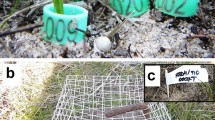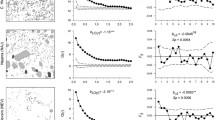Abstract
Fine-scale genetic structure (FSGS) in plant populations is expected to be influenced by variation in demographic processes across space and over time. I chose Hemerocallis taeanensis (Liliaceae), a perennial herb with a rapid population turnover, to quantify how demographic structure and FSGS change with a population’s history (i.e., density). Nonaccumulative O-ring statistic and spatial autocorrelation analysis (kinship coefficient, F ij ) were used to quantify spatial patterns of individuals and FSGS in four populations belonging to two population stages (expansion and maturation) in west-central Korea. The O-ring function revealed that significant aggregation of individuals occurs at short spatial scales during the earlier stage of population expansion, which reflects restricted seed dispersal around maternal individuals. However, this pattern disappears as the population density increases during population maturation, probably due to a high population density. Significant evidence of FSGS was found in two populations at the stage of population expansion (Sp, a statistic which describes the rate of decrease of pairwise kinship with distance, was 0.018 and 0.029). The results show that most seeds fall around maternal plants when initially established colonists proliferate at suitable microhabitats. In contrast to this, much lower Sp values (−0.003 and 0.004) were estimated for two populations at the stage of population maturation, which may result from the overlapping of seed shadows due to high adult density. All of these results demonstrate considerable variation in within-population demographic and genetic structures of H. taeanensis with respect to population temporal stage across the landscape.


Similar content being viewed by others
References
Alberto F, Gouveia L, Arnaud-Haond S, Pérez-Lloréns JL, Duarte CM, Serrão EA (2005) Within-population spatial genetic structure, neighbourhood size and clonal subrange in the seagrass Cymodocea nodosa. Mol Ecol 14:2669–2681
Cheliak WM, Pitel JP (1984) Technique for starch gel electrophoresis of enzyme from forest tree species (information report PI-X-42). Petawawa National Forestry Institute, Chalk River, Ontario, Canada
Chung MG, Kang SS (1994) Genetic variation and population structure in Korean populations of Eurya japonica (Theaceae). Am J Bot 81:1077–1082
Chung MG (2000) Spatial genetic structure in three populations of Hemerocallis hakuunensis (Liliaceae). Bot Bull Acad Sin 41:231–236
Chung MY, Epperson BK, Chung MG (2003) Genetic structure of age classes in Camellia japonica (Theaceae). Evolution 57:62–73
Chung MY, Suh Y, López-Pujol J, Nason JD, Chung MG (2005) Clonal and fine-scale genetic structure in populations of a restricted Korean endemic, Hosta jonesii (Liliaceae) and its implications for conservation. Ann Bot Lond 96:279–288
Clayton JW, Tretiak DN (1972) Amine citrate buffers for pH control in starch gel electrophoresis. J Fish Res Board Can 29:1169–1172
Epperson BK (2003) Geographical genetics. Princeton University Press, Princeton, NJ
Fenster CB, Vekemans X, Hardy OJ (2003) Quantifying gene flow from spatial genetic structure data in a metapopulation of Chamaecrista fasciculate (Leguminosae). Evolution 57:995–1007
Gapare WJ, Aitken SN (2005) Strong spatial genetic structure in peripheral but not core populations of Sitka spruce [Picea sitchensis (Bong.) Carr.]. Mol Ecol 14:2659–2667
Giles BE, Lundqvist E, Goudet J (1998) Restricted gene flow and subpopulation differentiation in Silene dioica. Heredity 80:715–723
Hamrick JL, Murawski DA, Nason JD (1993) The influence of seed dispersal mechanisms on the genetic structure of tropical tree populations. Vegetation 107/108:281–297
Hamrick JL, Nason JD (1996) Consequences of dispersal in plants. In: Rhodes Jr OE, Chesser RK, Smith (eds) Population dynamics in ecological space and time. University of Chicago Press, Chicago, IL, pp 203–236
Hardy OJ, Vekemans X (1999) Isolation by distance in a continuous population: reconciliation between spatial autocorrelation analysis and population genetics models. Heredity 83:145–154
Hardy OJ, Vekemans X (2002) SPAGEDI: a versatile computer program to analyze spatial genetic structure at the individual or population levels. Mol Ecol Notes 2:618–620
Hardy OJ, Maggia L, Bandou E, et al. (2006) Fine-scale genetic structure and gene dispersal inferences in 10 neotropical tree species. Mol Ecol 15:559–571
Haufler CH (1985) Enzyme variability and modes of evolution in Bommeria (Pteridaceae). Syst Bot 10:92–104
Ingvarsson PK, Giles BE (1999) Kin-structured colonization and small-scale genetic differentiation in Silene dioica. Evolution 53:605–611
Ishihama F, Ueno S, Tsumura Y, Washitani I (2005) Gene flow and inbreeding depression inferred from fine-scale genetic structure in an endangered heterostylous perennial, Primula sieboldii. Mol Ecol 14:983–990
Jacquemyn H. Brys R, Honnay O, Hermy M, Roldán -Ruiz I (2005) Local forest environment largely affects below-ground growth, clonal diversity and fine-scale spatial genetic structure in the temperate deciduous forest herb Paris quadrifolia. Mol Ecol 14:4479–4488
Jeltsch F, Moloney KA, Milton SJ (1999) Detecting process from snap-shot pattern: lessons from tree spacing in the southern Kalahari. Oikos 85:451–467
Kalisz S, Nason JD, Hanzawa FA, Tonsor SJ (2001) Spatial genetic structure in Trillium grandiflorum: the roles of dispersal, mating, history and selection. Evolution 55:1560–1568
Kang SS, Chung MG (1997) Hemerocallis taeanensis (Liliaceae), a new species from Korea. Syst Bot 22:427–431
Klaas BA, Moloney KA, Danielson BJ (2000) The tempo and mode of gopher mound production in a tallgrass prairie remnant. Ecography 23:246–256
Knowles P, Perry DJ, Foster HA (1992) Spatial genetic structure in two tamarack [Larix laricina (Du Roi) K. Kock] populations with differing establishment histories. Evolution 46:572–576
Loiselle BA, Sork VL, Nason JD, Graham C (1995) Spatial genetic structure of a tropical understory shrub, Psychotria officinalis (Rubiaceae). Am J Bot 82:1420–1425
Malécot G (1948) Les mathématiques de l’hérédité. Masson, Paris
Mitton JB, Linhart YB, Sturgeon KB, Hamrick JL (1979) Allozyme polymorphisms detected in mature needle tissue of ponderosa pine. J Hered 70:86–89
Parker KC, Hamrick JL, Parker AJ, Nason JD (2001) Fine-scale genetic structure in Pinus clausa (Pinaceae) populations: effects of disturbance history. Heredity 87:99–113
Ripley BD (1976) The second-order analysis of stationary point processes. J Appl Probab 13:965–981
Rousset F (1997) Genetic differentiation and estimation of gene flow from F-statistics under isolation by distance. Genetics 145:1219–1228
Rousset F (2000) Genetic differentiation between individuals. J Evol Biol 13:58–62
Schoen DJ, Latta RG (1989) Spatial autocorrelation of genotypes in populations of Impatiens pallida and Impatiens capensis. Heredity 63:181–189
Shimono A, Ueno S, Tsumura Y, Washitani I (2006) Spatial genetic structure links between soil seed banks and above-ground populations of Primula modesta in subalpine grassland. J Ecol 94:77–86
Sokal RR, Jacquez GM (1991) Testing inferences about microevolutionary processes by means of spatial autocorrelation analysis. Evolution 45:152–168
Soltis DE, Haufler CH, Darrow DC, Gastony GJ (1983) Starch gel electrophoresis of ferns: a compilation of grinding buffers, gel and electrode buffers, and staining schedules. Am Fern J 73:9–27
Sterner RW, Ribic CA, Schatz GE (1986) Testing for life historical changes in spatial patterns of four tropical tree species. J Ecol 74:621–633
Stoyan D, Penttinen A (2000) Recent application of point process methods in forest statistics. Stat Sci 15:61–78
Vekemans X, Hardy O (2004) New insights from fine-scale structure analyses in plant populations. Mol Ecol 12:921–935
Wiegand T (2003) PROGRAMITA, a software to perform point pattern analysis with Ripley’s L and O-ring statistic. Accessed January 21, 2007. http://www.thorsten-wiegand.de/towi_download_manual.html
Wiegand T, Moloney KA (2004) Rings, circles, and null-models for point pattern analysis in ecology. Oikos 104:209–229
Wright S (1943) Isolation by distance. Genetics 28:114–138
Wright S (1946) Isolation by distance under diverse systems of mating. Genetics 31:39–59
Young AG, Merriam HG (1994) Effects of forest fragmentation on the spatial genetic structure of Acer saccharum Marsh. (sugar maple) populations. Heredity 72:201–208
Zar JH (1999) Biostatistical analysis. Prentice-Hall, Upper Saddle River, NJ
Acknowledgments
The author thanks J. López-Pujol and E. Myers for making helpful suggestions, and M. G. Chung and J. D. Nason for discussion of the Sp statistic and many valuable suggestions for statistical analyses. This work was supported in part by a grant from ‘Eco-Technopia 21 Project (2004–2008), the Korean government’s R & D Program (#05002-0028-0) on environmental technology development’ through Y. Suh (Seoul National University, Republic of Korea) to M.G.C (Gyeongsang National University, Republic of Korea).
Author information
Authors and Affiliations
Corresponding author
About this article
Cite this article
Chung, M.Y. Variation in demographic and fine-scale genetic structure with population-history stage of Hemerocallis taeanensis (Liliaceae) across the landscape. Ecol Res 23, 83–90 (2008). https://doi.org/10.1007/s11284-007-0341-8
Received:
Accepted:
Published:
Issue Date:
DOI: https://doi.org/10.1007/s11284-007-0341-8




